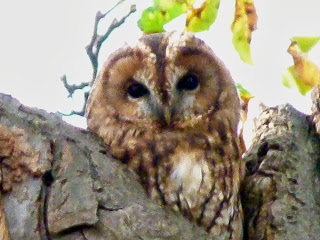The male Tawny owl was briefly visible in his favourite winter spot on the nest tree, directly above the hole where the pair's nest is. Paul Turner got a quick shot of him before he went inside.
We were worried about the effect of the strong wind on the nest tree, which is tall and hollow, but it stayed up, although a lime tree 50 yards to the south blew down, its stump showing it to be thoroughly rotten. Perhaps luckily, the nest tree, which is a horse chestnut, had been badly hit by leaf miner, and its leaves were shrivelled and about half fallen off, which reduced its wind resistance. Actually the park has not fared too badly, losing only a few trees and a fair amount of branches. It was nothing like the storm of 1987.
The young Great Crested Grebes whose nest was on an earlier wind casualty, the fallen poplar in the Long Water, were fishing for themselves around the wire baskets on the other side of the bridge.
There are so many fish here that even the most inexperienced young bird is bound to catch something, and indeed I saw one of them come up with a fish, only to dive immediately when a Black-Headed Gull swooped. The fish was small enough to swallow under water, so the gull was disappointed.
However, the same young grebes were very happy to be fed by their parents.
Apart from that, there was not much to see, just the familiar park birds on an autumn day. It is easy to forget how beautiful even the most ordinary birds are. I hardly ever take pictures of Great Tits, but they are well worth a close look.
The broad black stripe down his front shows that he is a male. Apparently female tits favour males with the broadest possible stripe. Both sexes seek mates with the brightest yellow colour, an indication that they are well nourished with insects, whose carotenoid pigments are metabolised to astaxanthin, the yellow pigment in feathers.
And even that very ordinary city bird the Feral Pigeon has its moments of elegance. Here are an affectionate couple billing and cooing, with the sunlight lighting up their iridescent neck feathers.





Thank you for the indeed elegant pigeons. Too often treated as second-class birds, I think,and with excessive vitriol. They are what they are..
ReplyDelete(of course I'm more excited by owls as well, but still)